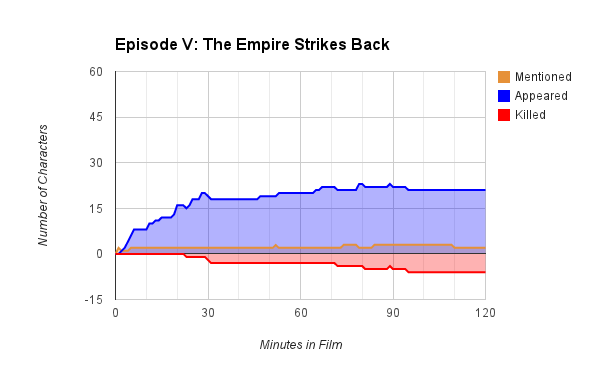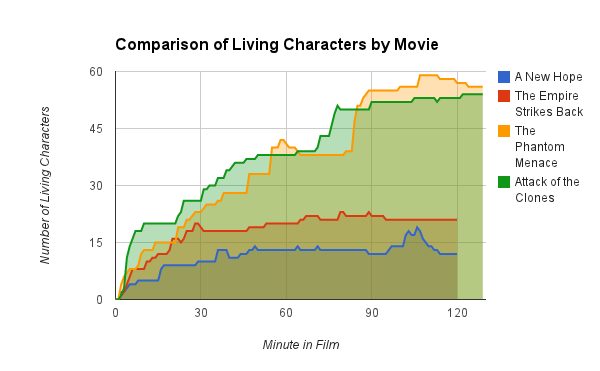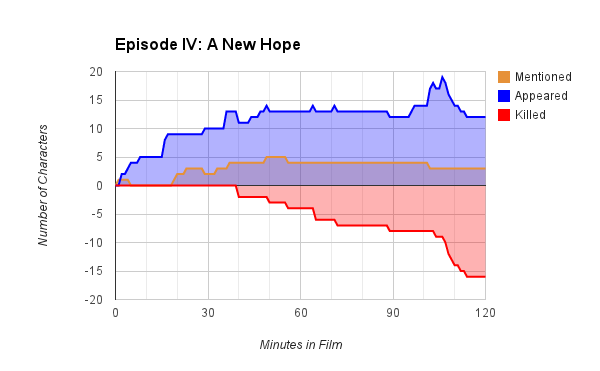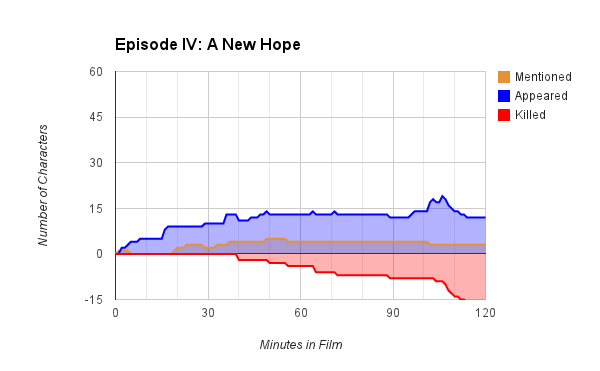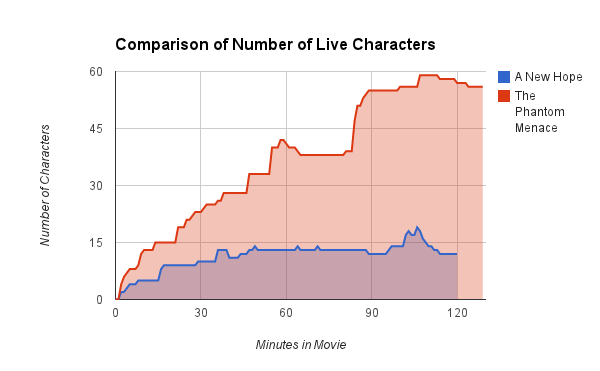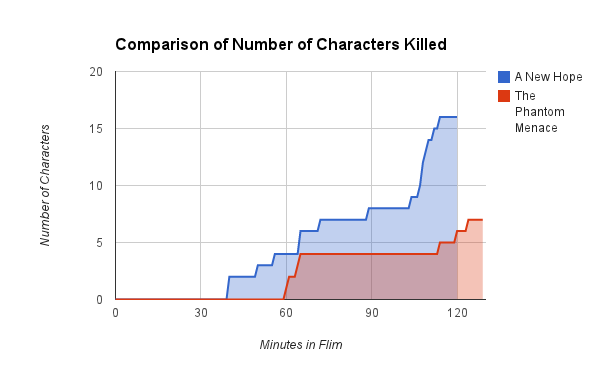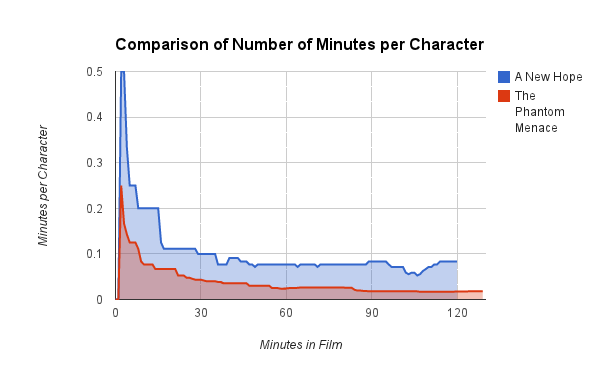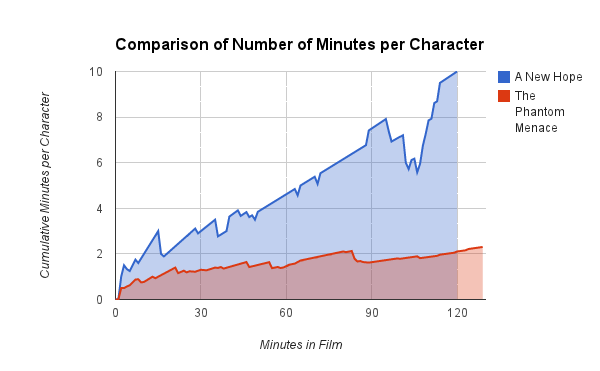Welcome back, everyone. Today we’ll be looking at the comparison of Star Wars episodes VI and III – Return of the Jedi and Revenge of the Sith.
Before we begin I want to show you something really quickly. It will only take a second. Really. A second. No time at all. There are four cuts in the following scene that we’re going to look at sequentially in the pleasant spirit of free use.
Okay, here’s A:
And now B:
Think of it like a visit to the eye doctor. Is A better? Or B? A? Or B?
How about C:
And now D:
Is C better? Or D? C? Or D? C, or D?
The first time I saw Revenge of the Sith (episode III) in theaters I remember having that weird feeling like I just missed something when I saw this scene. The best way I think I can get the feeling across is to point to that scene in The Matrix where Neo thinks he sees the same cat walk by twice. It’s something that you catch out of the corner of your eye, something that makes you wonder if you actually saw something or if your brain is just playing tricks on you.
I think I saw episode III three or four times in theaters (every time a different group of friends or family would suggest it), but I always forgot to pay more attention to this scene. It would just happen again and it would be over, and I’d be left with the same feeling that I’d missed something. I remember having the feeling that it had something to do with Obi-Wan’s eyes, but didn’t have the fortune of a rewind button. I was pretty sure that his eyes changed color during the scene, but it’s so fleeting that I had trouble nailing it down.
Well, (un)fortunately, now I do have a rewind button. I’ve owned the DVD of episode III for years now, but I think this might have been the first time I’ve watched it. This scene happened, I skipped back 20 seconds, watched it again, skipped back 20 seconds, watched it again, skipped back 20 seconds, watched it again, then picked my jaw off the ground. I caught it on the first rewind this time, but went back over and over to confirm what I thought I was seeing. I was honestly stupefied and embarrassed that this was in the film, let alone the DVD.
Like I said, there are four main cuts there. Shot A is the first piece, then it cuts to Anakin, then it cuts back to shot B, then cuts back to Anakin, cuts back to C, cuts back to Anakin, and then closes with the quick cut back to D. The middle shots (B and C) of Obi-Wan in this scene are clearly on a different day (or month!) than the start and close (A and D).
This was clearly just a callback shot when they either had something wrong with this piece or decided to add or change some dialogue or something. I’d understand if you needed an extra shot of Obi-Wan in a scene where he’s in the background or something, but this is one of the ubiquitous A-B dialogue (we’ll get to it…) scenes that permeates episode III. All that takes place are Obi-Wan and Anakin standing in front of a green screen delivering lines. From that standpoint it is not difficult to reshoot the entire scene, or even just Obi-Wan’s half, especially if you already have him in there to reshoot 8 seconds anyway. It’s not like you’d even need Anakin back on set, all you need is the person that is already there reshooting, and Anakin’s back of the head double.
This whole debacle elapses in less than 30 seconds, and they are the only people there. Give me Ewan McGregor, a guy that has a back of the head that kind of looks like Hayden Christensen, and a green bedsheet and I can reshoot this in my garage.
A director who cares at all about continuity would take note of the fact that actors don’t always look the same every day. If you wanted to splice in a shot (why would you do this?) instead of reshooting Obi-Wan’s whole half of it, you’d take note of how the actor was wearing his costume, his makeup, his facial hair, what his hair looked like, how much gel he put in his hair right before the shot, WHAT COLOR HIS EYES WERE THAT DAY, you know, the little things.
Now, I’ve looked this up on the internet since I figured this out, and some people have tried to just say that the shadows shifted or something and it’s no big deal. In case the A-B/C-D didn’t work for you above, here’s a side by side of A and B:
And of C and D:
I wish I was kidding. I wish that I had played around with this in photoshop or something. Realistically I could probably make the scene look better with an hour or so in photoshop.
Take note of the time difference, if you haven’t already. The first two cuts are separated by less than 6 seconds, the second two cuts by less than 2 seconds. What is the mentality that lets that slide? I’ve never been on a film set (or in an editing room), but I’d imagine that it must be someone’s job to make sure that something you just spliced in matches the things around it. It must be someone’s job to do what I just did – a few minutes of copy pasting and cropping stuff in MS paint.
Putting together a movie is probably pretty hectic, so I would be willing to cut them some slack on the theatrical release. Maybe you catch this in the 11th hour and it’s just too late to fix it. Like I said, this all happens pretty quick, and in theaters I was just left a little confused. But you should catch it. Someone should catch it. By 3am on the morning it was released I could have told you that you should take a look at that scene and figure out it something was wrong. How many people saw it at midnight? I’m decent at this – at best – but I’m hardly one in a million (or multi-million, considering the $16 million dollars made on midnight screenings alone; or many-million, considering the $158 million dollars this movie made in the first 4 days).
If you catch it too late you make a little note, hang it on your mirror or something, and make sure that your world-renowned editing and ‘special edition’ guys spend 20 minutes some morning doing some crazy Lucas magic to this scene. Or better yet, pay Ewan McGregor some crazy amount of money to regrow the beard and reshoot 30 seconds when he gets some spare time. Or – if you really want to Lucas out on this thing – save the dialogue but have the shot be of them walking at a distance and just CG both of them in there without needing actors at all. The bottom line is that while some of these options are less than great there were options on the table before you had to push a DVD out the door.
So why start with this? Why lead off with this instead of burying it in the bottom of the post or even a secondary post?
Because that’s the same attitude that produced a movie with such a dramatic failure present in it.
Okay, let’s get back on track. Eyes forward, class – whatever color they might happen to be.
I went into this week with an interesting pair of films before me. Going into last week I felt it was downright unfair to cast Clones up against Empire, as Empire – even as a standalone movie – is simply a fantastic piece of work. People seem to agree on that ( http://techcrunch.com/2010/12/29/star-wars-the-empire-strikes-back-added-to-national-film-registry/ ).
Even the first week I wasn’t expecting The Phantom Menace (often lambasted as the ‘worst’ of the prequels) to hold up to a landmark of film like the original Star Wars.
Return of the Jedi isn’t quite as strong as the others in the set, though. There’s the Ewoks taking on an entire imperial regiment, there’s all the stuff on Tatooine, etc. It’s still a good movie, mind you, but going into this week I considered it the weakest of the original trilogy.
Then there’s Revenge of the Sith. I remember watching this movie and thinking: “well, at least it wasn’t as bad as I and II”. Even the ever critical character of Mr. Plinkett over on RedLetterMedia (again, NSFW: http://redlettermedia.com/plinkett/star-wars/star-wars-episode-iii-revenge-of-the-sith/ ) seems to acquiesce on the fact that one of the prequels might not have been altogether awful. Coming from Plinkett that’s pretty enormous praise.
Given that this was set up to be the best of the prequels vs the worst of the original I thought I might get to see an interesting fight, and maybe even have episode III shine in a few places.
Oh. Oh, how wrong I was.
Let’s get the things you’re expecting out of the way, shall we?
So far we’ve been using – as our base for graphs – the scale determined by The Phantom Menace. Each of the movies to this point has mostly fit on that scaling, if perhaps a touch short of ideal (New Hope deaths were a touch off the graph). Return of the Jedi continues this tradition, and looks pretty similar to the trend we’ve seen in A New Hope and The Empire Strikes Back.
No surprises there, really. There’s a decent number of characters, and a long stretch there in the middle where no one dies. A fair number of the main characters are killed, though. People aren’t really mentioned or used as back story because things are being wrapped up.
Total deaths clock in at 11, five shy of A New Hope but five greater than The Empire Strikes Back. This fits, to some degree, especially given the near immortal fortitude of the Ewoks and the difficulty of confirming their fatalities (I’ve always said that I think one Ewok might have been killed – that’s all I counted here).
Let’s take a look at Revenge of the Sith.
Yes, the graph did decide to rescale itself. It’s because by the time Revenge of the Sith has wrapped up 19 actual named, credited, and important characters have been killed. That’s almost five pod races. Here’s the graph on The Phantom Menace Scale:
Revenge of the Sith is a film about killing a bunch of people, so I guess this number (19) shouldn’t be that shocking. Coming off the nearly pacifistic episode II (4 deaths) and the pod race fatality driven episode I (7 deaths, 4 from pod racing), it just feels like a lot. When you come out swinging with intent to almost double the deaths of the prior two movies, well, the deaths start to feel pointless and boring. Beyond that, many of the characters (e.g. the majority of jedi) haven’t been given any character development opportunity whatsoever, so it’s exceptionally difficult to care about them when they die.
In fact, the only Jedi that receive even minimal character development (Yoda, Obi-Wan, Anakin) end up living. And DO NOT come back at me with the claim that Mace Windu received minute one of character development. Kit Fisto ( http://starwars.wikia.com/wiki/Kit_Fisto ) received effectively equivalent character development as Mace Windu.
Tell me what motivates Mace Windu. Tell me what he does in his spare time. Tell me where he lives or what planet he’s from. Tell me who trained him, or who he trained. Tell me how he came to be on the council. Tell me how he feels about long walks on the beach.
And don’t you even think about telling me that I need to go to secondary source to find out this stuff. Star Wars fans should be the first to recognize the hierarchy of canonical sources (crap, I thought I was going to be able to write all these without saying ‘canonical’), and if you can’t make a movie work without giving people a reading list then you need to Peter Jackson that stuff and make it into 5 movies or something.
Anyway, who dies in episode III? Well, anyone that has made it to this point but has to have a reason not to be present in episode IV. All of the people who were shoved into the first few movies for no reason are now killed for no reason. Nute Gunray is still alive? Better kill him off. Finally.
Let’s briefly take a look at how the addition of these two movies fills out the overall graph we’ve been working on.
Pretty interesting – Revenge of the Sith looks more like the original trilogy than either of the other two prequels, at least up until the last 10 or so minutes. That could just be due to all the people that are killed, though, so let’s just look at the number of characters that have been introduced.
Wow, despite a strong last minute push by Revenge of the Sith, The Phantom Menace still ekes out that win. Who would have imagined that Attack of the Clones and Revenge of the Sith would end up tying? Here’s the numeric breakdown:
1st place – The Phantom Menace, 63 characters
2nd place – Attack of the Clones & Revenge of the Sith (tie), 58 characters
4th place – Return of the Jedi, 37 characters
5th place – A New Hope, 28 characters
6th place – The Empire Strikes back, 27 characters
Now that’s a list I’d be happy to be at the bottom of.
I’m not going to dwell on that today, but I think that if I come back to this in a few weeks to put together an overall comparison between trilogies that graph and ranking would be the place that I’d start.
I think that I learned a fairly large amount from coding the scenes in Clones and Empire, so I decided to give it another go here in Sith and Jedi. This produced a table of the same sort that I put together last week. Spend some time with it. Get to know each other.
| Jedi Scene | Mood | Sith Scene | Mood | |
| The approach | suspense | War! | tension | |
| Progress review | tension | Let’s kill some droids | action | |
| The droids | tension | The elevator | action | |
| Jabba the Hutt | tension | R2 kills some droids | action | |
| The ironworks | worry | That scene from Return of the Jedi | action | |
| Dancing, interrupted | happiness | Talk it out | plotting | |
| The bounty hunter | tension | Gravity | action | |
| Han Solo | suspense | Grevious | confusion | |
| Reunited | happiness | The bridge | action | |
| Return of the Jedi | tension | Going down | action | |
| The rancor | persistence | Homecoming | explanation | |
| Together again | worry | Padme | tension | |
| Sailing | planning | Grevious’ summer home | foreboding | |
| The sarlac | suspense | The balcony | hope | |
| The importance of good planning | action | Visions | foreboding | |
| Luke’s departure | planning | The little wooden thing | fear | |
| The emperor’s arrival | planning | Yoda | foreboding | |
| There is another | sadness | The report | tension | |
| Ben | worry | Anakin and Palpatine | plotting | |
| The rebel fleet | hope | The Council | tension | |
| The hanger bay | worry | Spyin’ | tension | |
| The millenium falcon | worry | Flyin’ | confusion | |
| The fleet | foreboding | Hanging out | reason | |
| Fly casual | suspense | The space opera | plotting | |
| The pacific northwest (of Endor) | suspense | Benefits of telecommuting | planning | |
| The pursuit | suspense | The Wookies | action | |
| Separated | worry | Apologies | understanding | |
| Fuzzball | curiousity | Commander Cody | playfulness | |
| Predictions | foreboding | Vision quest | whining | |
| A tasty treat that’s good to eat | suspense | Chasing Grevious | foreboding | |
| I am a golden god | reverence | Lizard ride | action | |
| The feast | suspense | Jedi robots | action | |
| Story time | relaxation | The car chase | action | |
| Revelations | worry | Battle plans | confusion | |
| Vader’s arrival | conflict | Emo baiting | whining | |
| The shield generator | planning | Cover your heart, Indy! | action | |
| The jump | setup | Chatting with Mace | tension | |
| The bunker | success | That scene from Fifel goes West | rumination | |
| Welcome, young Skywalker | despair | This party’s over | action | |
| Reinforcements | despair | Sorry I’m late | action | |
| It’s a trap! | confusion | On to business | planning | |
| Front row seats | anger | Yes sir! | foreboding | |
| The capture | despair | Order up! | action | |
| The calvary | chaos | Well that’s just unnecessary | action | |
| Defend the cruisers | action | Under control | tension | |
| The imperial fleet | foreboding | The value of swimming lessons | relief | |
| Fully operational | panic | Insert Wookie joke here | hope | |
| Open the doors | suspense | iShip | planning | |
| The star destroyers | worry | Obi-Wan’s escape | hope | |
| Do it! | anger | Anakin’s return | worry | |
| Lease an imperial walker today! | hope | Rebel One | worry | |
| Under fire | suspense | Mordor | foreboding | |
| Meet your destiny | tension | Approaching Coruscant | planning | |
| The best laid plans… | success | Under new management | betrayal | |
| Your feelings betray you | absolute despair | The temple | action | |
| The shields | jubilation | The senate | confusion | |
| So be it | absolute despair | The aftermath | sadness | |
| Here goes nothing | action | That scene from the Godfather | haste | |
| You were right | bittersweet | Hack all the mainframes | despair | |
| Quaid, start the reactor | success | A reasonable discussion | despair | |
| Victory | happiness | That scene from Lord of the Rings | sadness | |
| Funeral for a Jedi | closure | A stowaway | worry | |
| An Ewok celebration | celebration | A series of reasoned pleas | everything | |
| A diplomatic exchange | action | |||
| An office visit | action | |||
| Fightin’ round the world | action | |||
| Obligatory Yoda battle | action | |||
| Senate in recess | action | |||
| Gymnastics lessons finally pay off | action | |||
| Yoda’s escape | despair | |||
| That one level of Mario 64 | action | |||
| Highest ground is best ground | action | |||
| On bad tactical decisions | mixed | |||
| Leaving Mordor | sadness | |||
| Hang in there! | persistence | |||
| Obi-Wan’s return | hope | |||
| A rainy day on Coruscant | foreboding | |||
| Need a ‘will to live’ transplant | confusion | |||
| Luke and Leia | mixed | |||
| Nooooooooooooooooooooo… | anger | |||
| Blue glowy ghosts | hope | |||
| The droids | retcon | |||
| Back to Naboo | sadness | |||
| A great new civil works project | nostalgia | |||
| Visit Alderaan | hapiness | |||
| The farmstead | hope |
Here’s something you might notice. Revenge of the Sith is 8 minutes longer than Return of the Jedi. Revenge of the Sith has 86 scenes, while Return of the Jedi has 64. On average, scenes in Return of the Jedi are just less than 2 minutes each (actually 1.969 minutes). In Revenge of the Sith? A bit better than a minute and a half (actually 1.558 minutes).
In the first set of movies, I made the argument that not enough time was available to be allocated to each character. In Revenge of the Sith the problem seems that not enough time is available to be allocated to each scene. Things jump around everywhere. It is a tour de force of hyperactive excess. It feels like a child rushing to finish something that they should have started weeks earlier.
Let’s look for some bright spots. There’s certainly a lot less confusion present in episode III than there was in II. That’s good! Obi-Wan isn’t just wandering around dumbfounded the entire movie. That’s progress. What does he spend his time doing instead?
Well…acting completely out of character. Oh, so out of character. So very very out of character.
In episodes I and II Obi-Wan is constantly preaching patience and planning and blah blah blah. He’s seen twice now what happens when you rush into things alone (Qui-Gon against Darth Maul, Anakin against Dooku). So what does he do when he’s finally on the bridge with Grevious and able to maybe accomplish something, like maybe negotiations? Smirks and then wrecks up the place.
So what does he do when he finally tracks down Grevious again? Watch his movements for a bit? Come up with a plan? Surprise him when he’s alone or unsuspecting? Use his noted tracking skills to find where the other separatists went? Call in some support to surround him?
No, he just jumps down from the ceiling to taunt and provoke Grievous while he’s surrounded by enemy troops. Seems reasonable. Then they get in a car/lizard chase. Sounds like fun. What has planning ever done for him, anyway? Hmph. Adventure. Heh. Excitement. Heh. A Jedi craves not these things. You are reckless.
Oh wait, wrong movie.
Maybe there’s a doppelganger Obi-Wan in this movie, and that’s why sometimes his eyes are one color and sometimes they’re a different color throughout the movie. [I swear that he looks different in some of the Grievous scenes as well, but I just don’t have the heart to go back and check.] It was like giving the character a goatee to point out they are from the evil parallel universe.
Do you see what I’m reduced to here in trying to make sense of this movie?
Last week I broke things down in terms of mood to a number of different categories. Since that was mostly to focus on the element of confusion, I’m not sure what it’s going to tell us this week. The mood that seems to dominate Revenge of the Sith is action – or rather the lack of mood.
Three scenes in Return of the Jedi seem to be action for action’s sake, and two involve some of the space battle over Endor. The third is the sail barge battle on Tatooine. I’d give you three and a half if you pushed me a bit on the Ewoks, but to be fair they do try to evoke some emotion, if not a bit less effectively. In Revenge of the Sith?
25. Twenty-five scenes are predominately there for the action. Here are twenty-five 1’s for scale:
1111111111 1111111111 11111
Here are three:
111
There’s difference in the total number of scenes, so let’s deal with percents, to be totally fair. That’s 4.69% of Jedi, and 29.07% of Sith. We are talking just a bit shy of a clean order of magnitude.
Remember, I went into this week feeling like I might finally be able to come up with something good about the prequels. I really tried hard to find something good about this movie – something that would stand up to Return of the Jedi.
Jedi has some good emotional scenes. The things that stand out to me are the entire interplay between Luke, Vader, and the Emperor at the end of the movie, the interplay between Luke and Yoda, and the interplay between Han and Leia (and Luke for a bit). That’s…well, a good chunk of the movie.
I was really hoping to care for characters in Revenge of the Sith. There are really only two parts that stood out. The first is after Obi-Wan defeats Anakin (spoiler alert?) If you can get past Anakin continuing to whine while he tries to climb up the slope, Obi-Wan actually gives a pretty good performance. He sells you on the fact that doing this really hurt him, and that he’s sad. You get his despair, and his mourning. It’s a good performance by Obi-Wan, and it stands as a fitting capstone to this trilogy.
The only other part that evoked any emotion were the final few scenes where they are making blatant connections to the original trilogy. Amidala saying “Luke” and “Leia” stirs something up inside you. The shot of Owen and Beru holding Luke on the farmstead while watching the sunset with Obi-Wan looking on sadly is powerful imagery.
But, it’s not. Not if you haven’t already watched the original trilogy. If you’re watching the movies in numerical order for some reason (why would you ever do this?), that’s completely lost on you and you now have a movie completely devoid of emotion except for a speech by Obi-Wan on the slopes of Mount Doom.
I should come up with some graphs that keep me alerted to how many words I’ve gone since I’ve included a graph. Okay, I get it. Here’s a graph of how the moods actually break down when coded to simple categories.
Interestingly, Return of the Jedi and Revenge of the Sith tie in number of positive scenes and ‘other’ scenes. Remember, though, that Sith has the benefit of 22 extra scenes. Where do those 22 scenes end up? Well, we’ve actually already covered that – they go into action.
Oddly, I didn’t realize until making this graph that I didn’t code any suspense in Revenge of the Sith. My first reaction was ‘that can’t be right’, but after thinking about it for a minute I think it actually is, and it’s actually a pretty big weakness.
In Jedi, events are built up to. There’s dead screen time where you wait for an event to happen. You are given time to wonder what’s about to happen, and how things are going to turn out, and that’s what suspense is.
In Sith, it seems like Lucas has taken Yoda’s advice a little too literally. Things either happen or they don’t. There is no suspense. Time is not wasted building up to things, everything is clear cut. With everything that needs to happen there’s simply no time to let things build up. There was suspense in Attack of the Clones, right? Hold on a second.
Yeah, I went back to check, and there was at least a little. I didn’t code it at that point, but it makes me wonder how much suspense there was in Phantom Menace. There was some, right?
Anyway.
There’s something that I started thinking about that’s a little bit beyond simple action. It’s the permeation and buildup of scenes that are shot for effects – scenes that are less about characters and more about models and/or computer generated graphics. The Michael Bay effect, if you will.
It’s easy enough to code scenes that are predominately just shovels for effects. These are the scenes that are either all effects, or effects to the near exclusion of characters. Imagine two people fighting with swords which aren’t there, on a narrow platform that isn’t there, over lava that isn’t there, on a planet which isn’t there. Oh, and the people aren’t there either. All of it is just a guy at a computer monitor. We can only hope that the guy at the monitor has a drink in his hand.
The Star Wars movies have always had a strong effects backbone. A New Hope without the death star run or scrambles with TIE fighters is a weaker picture. Each of the movies – Return of the Jedi included – should be somewhat guilty of this. Let’s compare:
Moving on.
Remember I mentioned the A-B dialogue problem? Well, even when there are actual characters on screen in Revenge of the Sith, they are often standing, sitting, slowly walking, walking then stopping, stopped then walking, sitting then standing, standing then sitting, or some other bizarre combination of all of the above, in pairs, in front of green screens. You put a camera over one person’s shoulder pointing at the other actor and the other camera over the second person’s shoulder looking at the first. [Note: I’m not even treating green screen backgrounds in the above look at CG driven scenes]
You have them talk, fill in a background, and it’s ready to go. It gets hard if they’re walking too much (probably?), which might explain why they always stop walking at some point. They might start walking again, but that’s a good tip that the scene (and conversation) is about over. How does that look?
Looks pretty similar to the CG graph above.
I wonder what would happen if we looked at both of them together?
Hmmm, there’s probably a lesson there. Disney, take a look at that graph a few more times.
Hang in there, folks, we’re almost through this. I can see the end ahead of us.
One of the things that I find myself recognizing in movies these days is the points when I consciously or unconsciously allow for suspension of disbelief. A movie (or any entertainment) that has fewer points where suspension of disbelief has to occur flows better. The smaller the suspension that must be made, the better.
Return of the Jedi and Revenge of the Sith are similar in the sense that both movies are the culmination of plans laid out by the emperor.
In Return of the Jedi the emperor’s plans have been progressing since some point in Empire, when he realizes that Vader’s son lived. His plans in A New Hope were foiled by the rebels with the destruction of the death star.
In Revenge of the Sith the emperor’s plans have been progressing from the opening crawl of The Phantom Menace. My initial inclination was that the death of Darth Maul was a wrench in his plans, but it doesn’t seem to have been. Even that setback seems to have been a part of the plan to draw Anakin to him. Darth Maul wasn’t his apprentice, he was a pawn.
In Return of the Jedi there are a few places where the emperor’s plan could fall apart. The plan is pretty tight, though, as the rebels have fallen into a trap that the emperor set. The rebels could have not fallen into the trap, but it wouldn’t have foiled anything – the emperor would still have the upper hand. There are really only two places where the emperor’s plan could have failed.
The first is that ‘an entire legion of the empire’s best troops’ could have been bested by a rag tag group of native teddy bears. The second is that Vader could be turned by Luke against the emperor. Both are pretty small risks for the emperor – both of those things are pretty rare events. That’s why they’re powerful when they occur. The emperor’s plans have also been foiled once in A New Hope and The Empire Strikes Back, so he’s not shown to be all powerful and infallible.
In Revenge of the Sith, well…I put together a list.
| Plan falls apart | Minute |
| Anakin is killed by other ships | 6 |
| Anakin is killed by Doku | 12 |
| Anakin doesn’t kill Doku | 14 |
| Doku uses last words wisely | 14 |
| The ship explodes under fire or while on fire | 16 |
| Grevious kills Anakin | 18 |
| Obi-Wan actually negotiates for once | 19 |
| The ship crashes or isn’t pointed toward runway | 21 |
| Anakin consults a doctor about childbirth | 31 |
| Yoda uncovers child or relationship | 33 |
| Council doesn’t appoint Anakin at all | 39 |
| Anakin actualy spies on Palpatine | 40 |
| Anakin trusts the council | 45 |
| Anakin questions Palpatine’s knowledge of Sith | 46 |
| Amidala questions Anakin’s methods | 53 |
| Separatists refuse relocation to Mustafar | 57 |
| Anakin kills Palpatine | 64 |
| Anakin goes to the senate instead of to Mace | 67 |
| Mace goes to the senate instead of confrontation | 67 |
| Mace uses patience and planning before attack | 67 |
| Jedi actually know how to fight | 71 |
| Mace agrees with Anakin to arrest Palpatine | 74 |
| Anakin agrees with Mace to kill Palpatine | 74 |
| Anakin stops Palpatine from killing Mace | 75 |
| Anakin arrests Palpatine after the fact | 75 |
| Amidala questions Anakin just a bit more | 89 |
| Obi-Wan kills Anakin/Anakin dies of wounds | 120 |
| Nute Gunray defects, shares knowledge of Sith | EVER |
Here’s what it looks like if we graph it, as if we really needed to see it:
In Revenge of the Sith the emperor not only has a ridiculously complex and convoluted plan, but nothing about it ever goes wrong. If you look at the events of The Phantom Menace and Attack of the Clones, every single event is planned by the emperor to produce Vader. Things happen and Palpatine is always there, smirking and happy with himself. In the prequel trilogy the emperor is all powerful and infallible.
Even Superman needs kryptonite. Even Doctor Manhattan needs tachyons. Whoops, now I want to sit down and reread Watchmen. The emperor has none of these things.
He is, by all extent, more powerful than Superman or Doctor Manhattan.
Read that one more time. Really think about that.
This, to a large degree, is one of the things that accounts for the lack of suspense in Revenge of the Sith (and perhaps the prequels overall). Call him an antagonist or a protagonist – he’s certainly one or the other. An infallible being with seemingly limitless power makes for a boring character. You never expect him to fail because he never does. If he wants something, it happens. If he plans something, the plan succeeds.
Show him being even a little sad that Darth Maul has been killed. Show him changing his plans on the fly. Show him once not having that smug sense of satisfaction and the audience might start to imagine for even a moment that his plans might fail, even if they don’t.
How easy is that? Pretty easy.
There was one last thing that I wanted to look at during these two movies. It has to do with music.
The original trilogy plays out like Peter and the Wolf. Even if you’ve only seen the original trilogy a few times you can probably hum a few bars of a few different pieces of the original Star Wars score. If you know one piece you almost certainly know Vader’s theme: the Imperial March. You’d probably also recognize Luke’s theme – it’s a big part of what’s thought of as the main Star Wars theme.
Leia has a theme that’s kind of close to Luke’s, but softer. The final big one is that of the emperor. The emperor’s theme is recognizable as the only piece (unless I’m mistaken) in the original trilogy with a chorus – think of the music with deep low chanting.
These themes build and change across the three original films. The emperor’s theme isn’t even present until Return of the Jedi (because the emperor isn’t really present until Return of the Jedi), though it’s still clearly identifiable due to how unique it is. It’s also clear due to the fact of how directly tied to the emperor it is. If the emperor is on screen you’re going to be hearing at least a bit of his theme.
Even with all the other coding I was doing I had a pretty easy time pulling out a bunch of these themes during Return of the Jedi. If you listen to them closely you can tell what’s going on without even listening to the dialogue.
If you’ve gotten to this point I’m really hoping you’ve seen the movies, so I feel that saying spoiler alert is kind of unnecessary. But, just once more, here come some pretty major spoilers. MAJOR SPOILERS. If you’ve just been reading so far thinking that well maybe you’ll never watch Star Wars just stop now and watch the original trilogy. Here comes full spoilers of the end of the main plot line. You have been warned.
The best use of this music that has been building for three films is the last 15 minutes or so with Luke, Vader, and the emperor. You have a clear picture of each theme at this point, and as things start shifting one way or another each theme stands out over the others.
This culminates as Luke is hiding from Vader in the emperor’s throne room. There’s bits and pieces of everyone’s themes up to this point, but while Luke is hiding he’s trying to feel for the good in Vader, but Vader is doing most of the talking. Vader is doing the emperor’s bidding, and you hear a slow build of the emperor’s theme.
Vader is also searching Luke’s feelings, and Luke is trying to hide the fact that Leia is his sister. He fails, and Vader senses that there is another Skywalker. Vader becomes overjoyed, and then Luke gives in to everything that the emperor has wanted – he’s filled with anger and hate and directs it all at Vader. He yells and attacks Vader with all his hate and fury, finally willing to do what he has so far refused – to kill Vader.
What follows is then the strongest and most powerful rendition of the emperors theme in the movie as Luke goes nuts on Vader. The music comes to a crescendo as Luke knocks down Vader, continues to strike with all his strength, and cuts off his hand – leaving him helpless. Luke has him defeated at this point, and the regular emperor’s theme returns as the emperor walks down the steps, chuckling.
Luke looks at what he’s done, sees Vader’s mechanical hand not unlike his own, and regains his composure. The emperor’s theme fades as Luke calms himself and refuses to kill Vader. Luke’s theme emerges over the emperor’s, as Luke tells the emperor that he has failed, that he will never turn to the dark side. That he is a Jedi, like his father before him.
The emperor is now furious, and starts to use force lightning Luke. Vader pulls himself up and stands next to the emperor as the emperor continues to attack Luke, who cries out for help. The emperor’s theme again emerges as Luke finds himself defeated. As this continues, the camera moves to Vader and the emperor’s theme begins to mix with Luke’s theme, revealing Vader’s internal struggle between the two most significant people in his life.
“Now, young Skywalker. You will die.”
Luke’s theme bursts through as Vader picks up the emperor and throws him over the railing to his death.
All the themes fade as Vader collapses to the ground, exhausted.
Vader is mortally wounded in the attack, and Luke tries to help him to his shuttle. The death star is in chaos. Vader stops Luke along the way and asks Luke to remove his mask, knowing he is about to die. Luke helps Vader remove his mask and you hear a very light violin rendition of the imperial march as he’s taking it off. As he speaks his last words the music that plays is a continuation of this on all the lightest instruments that the orchestra could find, including on – what is that, a french horn? – that is otherwise mainly (perhaps exclusively) used for Luke’s theme.
Vader draws his last breath and the well-known main notes of Vader’s theme are played out slowly, one by one, with a harp. The music that has been used across these films to underscore the main antagonist is now being used to show that there was in fact still good in him. It’s strikingly beautiful, and transcends dialogue.
It’s also pretty easy to pick up on. I’ve been watching these films with a pretty critical eye, but was watching Jedi with my wife – she picked up on and pointed out this use of the harp-played Vader’s theme before I was able to say anything about it. Things in the original trilogy are kept simple to keep them powerful. Parsimony is the bedfellow of fine focus. John Williams has received a lot of accolade for his original trilogy scores, and it’s well deserved.
John Williams also had the (mis)fortune of working on the prequel trilogy. What was he able to deliver there?
I own copies of all the Star Wars soundtracks, which does mean that yes at one point I went out and even bought copies of the prequel soundtracks (along with also buying DVDs of the prequels at some point). I always thought that there were two things weird about these soundtracks. The first was that they were only one CD, while the original trilogy soundtracks were two CDs. The second was that the songs weren’t even ordered on the CD based on the movie – they were just sort of randomized.
I began to notice one of the potential reasons for this when I was trying to code some of the music in Revenge of the Sith. It’s actually something I wasn’t expecting, so I didn’t figure out to code it in time, but a lot of scenes just don’t have any score at all.
We can actually figure out some of the discrepancy from looking at the run time of the soundtrack against the run time of the movie:
The astute (or still awake) reader will notice that the score of Return of the Jedi is actually longer than the movie. This is not due to the fact that the Return of the Jedi soundtrack has extras and alternative versions on it, as I made sure not to include those. It’s actually because the run time of the movie that I’m using is computed up to but not including the credits – all the calculations I’ve done are based on the length of things without credits, as those are not really a scene. It’s a minor thing, and if I went back I could fix this graph and make each of the blue bars just a little longer.
It’s rather insignificant to the point of the graph, though. In Jedi the music follows the story almost exactly. It’s a big part of the film and helps to support a lot of what is going on. I could probably pull up a random track and tell you what’s going on in the movie due to how well the music and plot match to each other.
In Revenge of the Sith the music is…well, I don’t even know. It’s almost an afterthought. The reason that the CD isn’t in movie order because if it was you might try to do something silly, like sync it up to the movie with the movie muted. You’d feel kind of silly when your CD ended with an hour remaining in the movie.
There’s also the question of themes. We’ve discussed how there are clearly identifiable themes in the original trilogy. In the prequel trilogy the only thing that keeps coming back over and over is ‘Duel of the Fates’ – something that I regarded on first (and repeat) viewing of Phantom Menace as Darth Maul’s theme. Remember Darth Maul? He’s still relevant, right?
I tried to listen for unique themes that I could recognize in each of the movies. We’ll break it down again by scene:
Keep in mind (in many of these graphs, I might add) that Return of the Jedi has 22 fewer scenes, which is why it tends to end earlier on the graph.
So Revenge of the Sith has a little bit of music to set the tone. Those last three spikes, though, are a scene with the imperial march when Vader and the emperor are overseeing the construction of the death start, and then two scenes with Luke’s theme.
There’s a few other sprinklings of Luke’s theme, a bit of Yoda’s theme, some Duel of the Fates, and even some things that I’m going to call Amidala’s and Anakin’s themes (I think it’s a stretch, though). It’s just so…half-assed.
The bottom line is that Revenge of the Sith was so bad that it made John Williams not care.
This brings us to an important question: just how bad is episode III? Was my initial inclination correct that it’s the strongest of the prequels?
I’m shocked by it, but when I finished watching it I kind of longed to just go back and watch episode I. That’s right. The Phantom Menace. I think The Phantom Menace – with all its many problems – is a better movie than Revenge of the Sith. I can’t help but shake my head when I try to say that sentence out loud, but I think I have to stick with it.
Even the ridiculous love story of Attack of the Clones seems palatable compared to Revenge of the Sith. At least it’s a story.
I’m going to have to diverge from common opinion here and say that Revenge of the Sith is the worst of the Star Wars prequels, and by fiat, the worstest Star Wars movie eveeeeeeeer.
It’s partly a problem of doing prequels (so stop doing prequels, everyone!). You can’t let the characters drive the story because you know they have to get to a certain place. You can let them drive the story for a while, but then you need to reel them in and have them act completely out of the character that you’ve just built to get them back on track.
By numbering movies before you’ve written all of them you also run the risk of running out of numbers. Episode III suffers from this as well. There are things in this movie that should have been cut so that other things could be given enough time to be understandable. Yoda going to the Wookies has little impact on the story other than to make people say “wow, I know what Wookies are!” and to give Yoda a explanation of not getting wiped out by order 66 or being in the temple when Anakin arrived. That explanation could have taken a lot less time, or be wrapped up in something else.
I’m just going to toss my first thought out here – maybe Obi-Wan could have acted with patience when he found Grievous, and called in and waited for reinforcements. The council, recognizing Grievous as an important threat, could have sent Yoda (and maybe another throwaway Jedi or two for Grievous to kill) to help Obi-Wan deal with that threat adequately. It’s super important that this goes well – remember that the council was more than willing to recall Obi-Wan and Anakin halfway across the galaxy for the opening scene.
Maybe without the Wookie scenes there would be time to show some more of the hints of friendship between Obi-Wan and Commander Cody (the only named clone trooper), and then show Cody’s struggle with executing order 66 or staying true to his friend. That struggle of Cody’s could be used as the element that allows Obi-Wan and Yoda to escape. You’d also have an opportunity to feel for one of the clone troopers, as well as learning more about Obi-Wan. Wow, there’s some character development you get out of it, too.
Special bonus? Two (or three, or four!) on one light saber battle. Something for the kids, you know? A fight with a four-armed guy makes a lot more sense when you have two or three guys working on it, anyway.
Honestly, that didn’t take much thought. I didn’t pause while writing this to come up with that, nor had I thought about it before. It literally took almost no time at all. Like I said earlier, I’m nothing special – get together a bunch of smart people in a room, give them the freedom to express their opinions and be critical, give them some time to brainstorm on this stuff, and you’ll get plenty of ideas that are drastically better than this one in no time at all.
Episode I and II had flaws. Those flaws were well known before episode III was produced. Given those flaws, episode III should have received even minimal critical review at the script stage. It doesn’t feel like it did in the slightest. What could I say that I haven’t already?
If you go to the zoo and watch the monkeys long enough, you’ll witness monkeys eating their own feces. It happens. Simple biology would point to the fact that this fecal matter will pass through that monkey again, becoming what could be perhaps construed as some sort of concentrated double feces. That is the best that I can do to describe Episode III: Revenge of the Sith.
So, there you go.
You’ve earned some bonus questions by this point, and soon you’ll have them. First I wanted to just say thanks for reading. If I had any idea how long this would have become as I was sitting down to write that first post I probably wouldn’t have done it. It’s been a lot of fun, and I think it’s changed the way I look at these movies. I hope it’s done the same for you.
Anyway, questions!
– How long has Palpatine been sitting up in this ship captured? I always thought his capture had happened just before the movie starts, and Dooku was in the act of fleeing with his prize (instead of just hanging out in orbit). Later Anakin says that he and Obi-Wan were specifically called back from the outer rim to rescue Palpatine, which means that at least some time has passed. Are they the only Jedi that know how to fly a ship, by the way? Why were they so important to be recalled from their other duties?
– Why doesn’t the trade federation invest in a ton of those tiny droids that latch on and completely destroy your ship? Those would easily take down star destroyers – they might have been able to take down the death star. It’s not designed to deal with single-pilot fighters, how in the world would it ever cope with basketball sized droids?
– How is it that R2 is almost as dexterous as a Jedi in Return of the Sith, but in the original trilogy he can’t do much of anything? Did he take a penalty to DEX for acting out of alignment or something?
– Are the Jedi specifically supposed to be captured? Because there are several places where droids have the drop on them and could easily kill them if they simply shot their blasters.
– Obi-Wan makes exceptionally short work of two of those walking droids that in the prior movie seemed exceptionally difficult for Jedi to deal with, even in one-on-one situations. Has he been training specifically against them? Also, why did they replace the droid destroyers? They can’t be cheaper to make (as fully humanoid robots would be), and they’re barely better than the regular droids.
– Why does Obi-Wan not lose his legs when they’re crushed by a metal platform against a metal floor? I remember wondering this in theaters, and maybe it’s just a bad angle or bad CG.
– If all it took to free Palpatine was to wave a hand anywhere remotely near the locks why didn’t they do that when they first entered the room? Sure, Palpatine isn’t a Jedi, but he would at least not be a (literal) sitting duck if Dooku actually wanted him dead. I mean, just show Anakin fiddling with something on the side of the chair for 2 seconds.
– Seriously, where did the clones get those ships? Why is this never addressed? Why are the clones important at all, compared to these ships?
– When the ship starts to plummet toward the planet gravity goes all screwy. This is a ship that spends most of its time in space, right? So, I guess the artificial gravity was knocked out, sure. This ship starts in medium to high orbit around Coruscant. Coruscant is not shown to have any reasonably different gravity than Earth. The International Space Station operates in low-Earth orbit. Pull up a video of the space station crew floating around in what is effectively zero g. Gravity is an inverse square laaaaaaaaaw.
– For that matter, why would a ship that high in orbit immediately plummet toward the ground with the same force as if it had been a stone pushed off the edge of a table?
– Is Grevious in on the conspiracy too? Why not just let all three of them die trapped in the ray shield? Also, add ray shield to the list of super overpowered devices that could single-handely win the war if used wisely instead of just once. Let’s check in on that list: droid destroyers, Gungan energy balls, flying droid basketballs, ray shields, patience.
– In another situation where the Jedi seem to be full instigators of this war, Grevious brings Obi-Wan, Anakin, and Palpatine to the bridge for ‘negotiations’. If he wanted them dead, he could have easily killed them in the ray shield. Obi-Wan responds to Grevious acting fairly peacefully by breaking out of his bonds and attempting to kill everyone in the room. Then, once people (sorry, droids) are simply running away he and Anakin wrap things up by brutally killing them as they flee.
– Why is it that every other droid stops working when you decapitate it, but Grevious’ guards don’t need their head at all to function? Why even put a head on them? Is it just like a place where you can store stuff? Like your keys?
– What does Grevious do to the ship to make it start crashing? It seems perfectly stable before he jumps out the window, then after he does that there are just random explosions and the ship starts to break in half. I guess that was a load-bearing window?
– When did Obi-Wan get a sense of humor? In the last movie he was super job-focused and stern and in this movie he’s constantly cracking jokes.
– Why would Corusant have any land dedicated to what is effectively an airport? Since there are no ships in this universe that rely on air moving over wings to produce lift, there are no ships that require more than their footprint to take off or land. There is not a single ship present in any movie that needs any significant ground to take off. Now, Coruscant would likely have plenty of spaceports – oh, wait, we’ve already seen a bunch in prior movies. They’re just places you park your ship next to, or fields where you land it gently in an area exactly its size. Star destroyers land at the end of Attack of the Clones, and they just go gently up and down – no runway needed. Runways are for craft that either need a distance to get up to speed to generate lift, or for those that have no means of landing other than…well, controlled freefall. There would be no reason for a runway to exist on Coruscant, and on a planet that is utilizing 100% of space (the whole planet is one big city!) there’d be no reason to keep any around even if they were a throwback to a forgotten age. Let’s consider – Anakin doesn’t seem to have very much control of the ship at all. At best he might be able to make exceptionally minor pitch yaw and roll changes, but certainly none to speed, as the ship is basically in semi-controlled freefall. That means there are either a lot of runways (for no reason), or he just happened to be aimed at the one remaining one that’s on the Coruscant Registrar of Historic Places or something. Whoops, sorry about destroying that historic air control tower.
– The ship is plummeting toward the ground at or near terminal velocity. Other ships come along side and start shooting something at the fires to put them out. The streams of liquid don’t seem at all impacted by the fact that well…wind. I’ve heard people come up with the notion that this is super special heavy firefighting liquid that would like fall faster or be resistant to air pressure or something, because this is a situation that happens all the time, right? I guess that would explain why Coruscant had so many runways. If you were spraying this stuff not in full freefall you’d need that much extra pressure to ever send it any distance, which would simply be ineffectual. That said, even if this was molten lead it is still subject to some pretty simple physical forces that are simply not on display.
– Anakin says they (him and Amidala) don’t need Obi-Wan’s help, and implies that they can handle things on their own. So, then next thing he does is go to Yoda. Why? He’s shown to be much closer to Obi-Wan.
– Amidala suggests that Anakin talks to Palpatine to try to get him to go back to negotiations to try to bring a peaceful end to the war. Anakin gets super angry and tells her that ‘she sounds like a separatist’ and that she should ‘bring that up in the senate where it belongs’. Why are the Jedi so intent on waging a full out war with no end when in the prior movies they are set up as ‘guardians of the peace’ and say that they ‘cannot fight a war for you’? Guess what, Jedi? You’re not only fighting a war, you’re leading a war. Also, why does Amidala continue to take all this abuse? Did she develop all these self-esteem issues while she was child ruler of an entire planet?
– In episode II they go all out to catch Dooku because they say that if they can catch him they will instantly win the war. At the start of episode III they kill Dooku, but fail to catch Grevious. Shortly thereafter, they say ‘if we catch Grevious it will end this war’. How many times will it take them to catch on that there might be a second in command?
– Obi-Wan’s eye color and hair. OBI-WAN’S EYE COLOR AND HAIR.
– Grevious has a reach that exceeds the length of a lightsaber, and he has with him four lightsabers. All he has to do is sweep two lightsabers each in different, paired directions, at a distance apart just longer than a normal lightsaber. Unblockable. Or swing two in that fashion and stab with the third. Or just clap two of them together from opposite sides at the same time. Or, you know, just let Obi-Wan win. Grevious has to be in on this plan, too, right?
– Since when do blasters set things on fire? Like, upon hitting something errupt into flame? Is Grevious made of combustible material?
– Why does Anakin change his mind so incredibly fast after Mace is killed? He’s immediately regretful that he helped Palpatine, and originally came there to arrest him. The only thing that Palpatine is holding over him is the power to save people from dying in childbirth, and then Palpatine is like “oh yeah, I totally don’t know to do that, but I’ll definitely look into it”. Why doesn’t Anakin go get some other Jedi or just try to kill Palpatine right there? If the idea is that he’s giving in to his anger he should be pretty angry at Palpatine at this point.
– To go back to my questions about episode II, Obi-Wan in episode III says that the Chancellor will not be able to control the thousands of planets in the republic, while Dooku claimed that at least 10 thousand would defect from the republic to the separatists’ cause. Order of magnitude discrepancies here.
– Before Nute Gunray is killed he says that ‘the war is over’ and that ‘Darth Sideous promised us peace’. This further gives evidence that if the Jedi had tried to negotiate at any point they might have found themselves in an interesting discussion.
– Who is the video editor in the Jedi archive? Or is Obi-Wan just really really good at search queries? The notion of “let’s look at the security footage” leads to pulling up the 5 seconds of important footage from two different time points and areas – why would the emperor even have come to the Jedi temple anyway?
– Anakin says that the Jedi turned against him? Which ones? Mace? By that point he had apologized to Obi-Wan for his earlier actions, and was in the process of redeeming himself in Mace’s eyes. He had no reason to believe that any Jedi had turned against him at that point, unless you count fighting back turning against him when he came to kill them.
– Why is governor Tarkin on the bridge with the Emperor and Vader? 20 years pass before he is relevant. As a governor he can’t be that important, other than what he will eventually become.
And a few questions about Return of the Jedi:
– The opening crawl says that the new death star is even more powerful? How?
– When Luke comes to Jabba he walks in – peacefully – and simply turns away the guards with the Jedi mind trick. In the prequels those guards would have been cut to CGI pieces. Why would Luke not just slaughter them? They don’t have names and they’re not people, so it’s totally okay to just kill them, right? I’m so confused after watching the prequels. So confused.
– When the sail barge is hit is lists to the side, but why would it stay up at all?
– Why would they bring the droids to Endor at all? Is hilly forest one of R2’s favored terrains?
– Can anyone just jam anyone’s comlinks on speeder bikes? Why would it be the center switch? Wouldn’t that be something important?
– Why have we as a culture allowed Lucas to go in and make horrible changes to these movies?
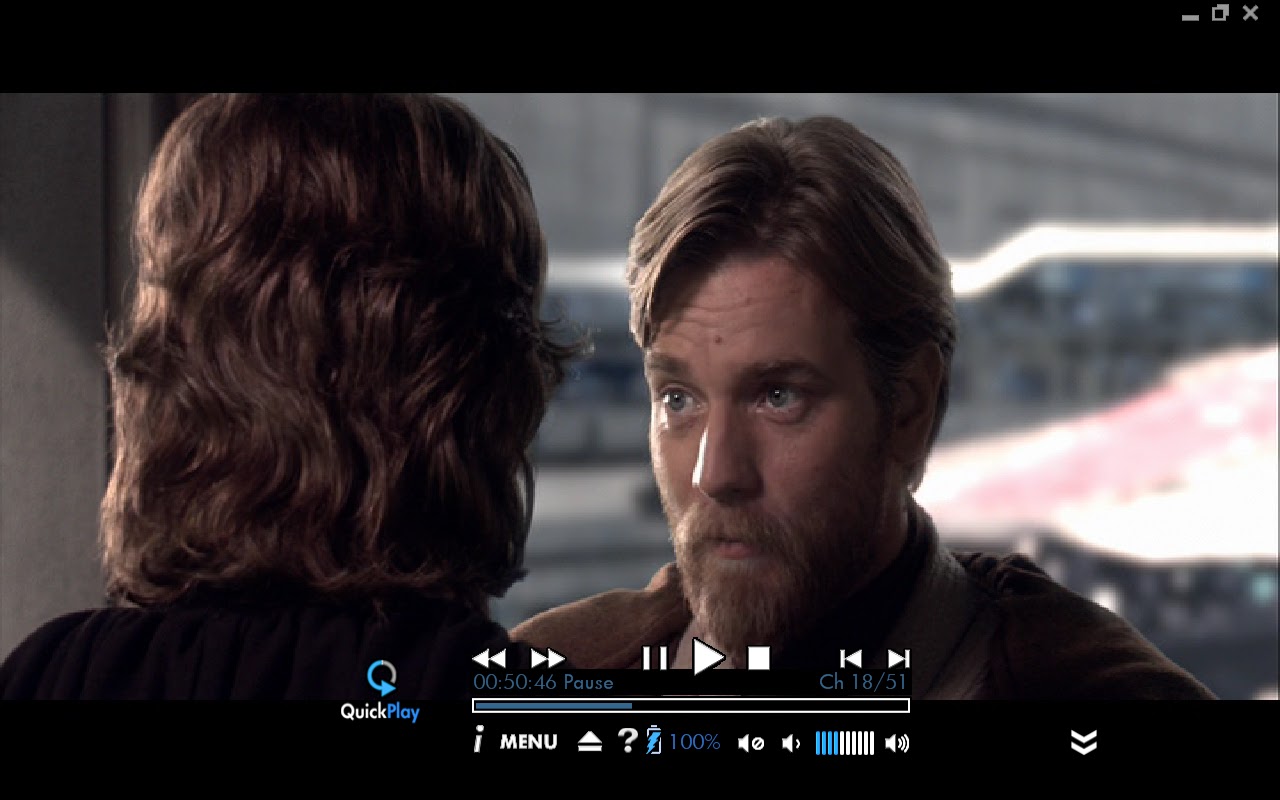
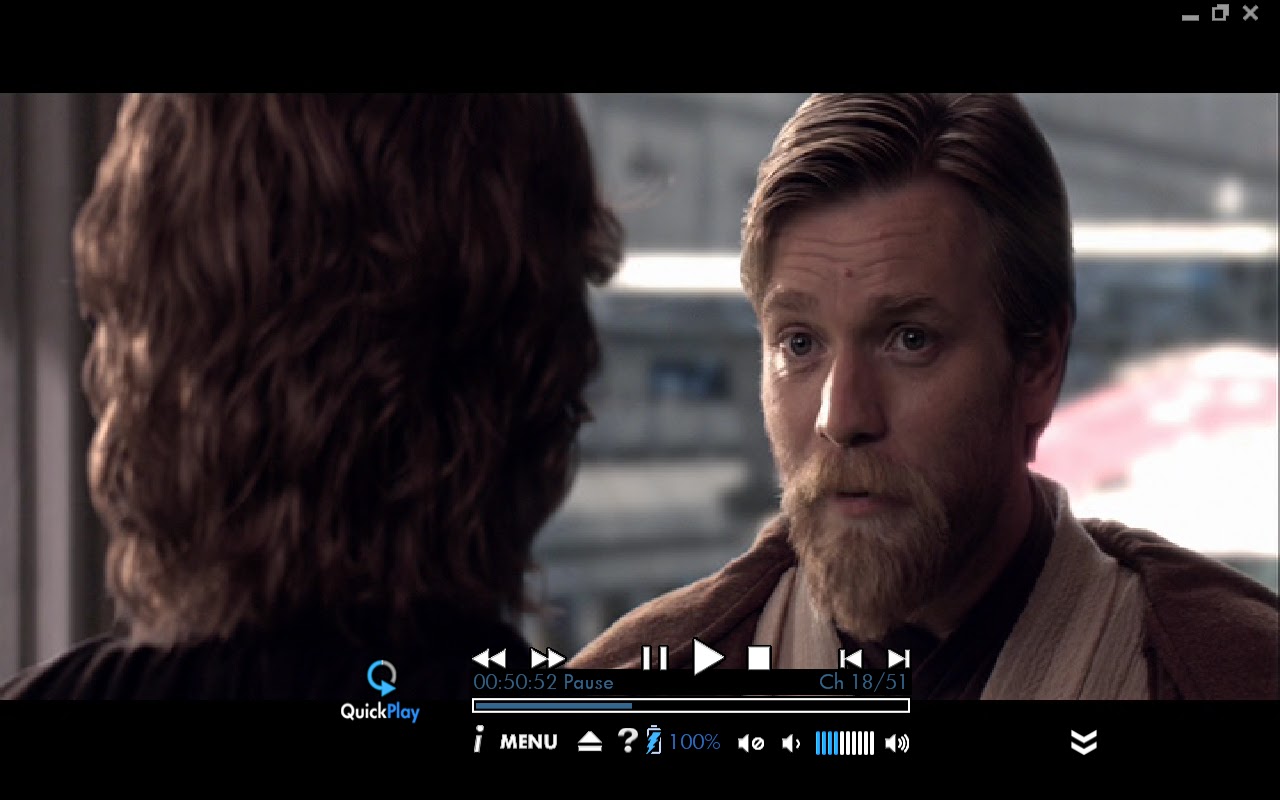

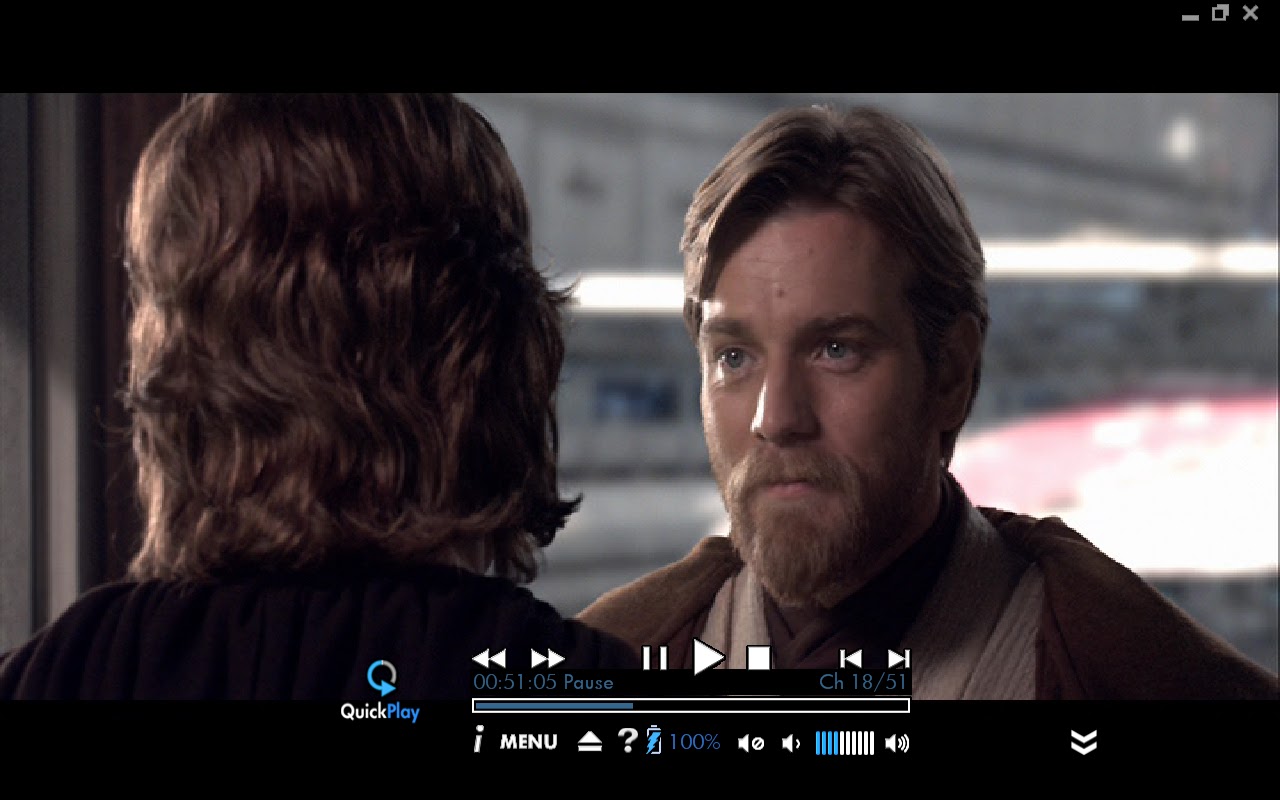
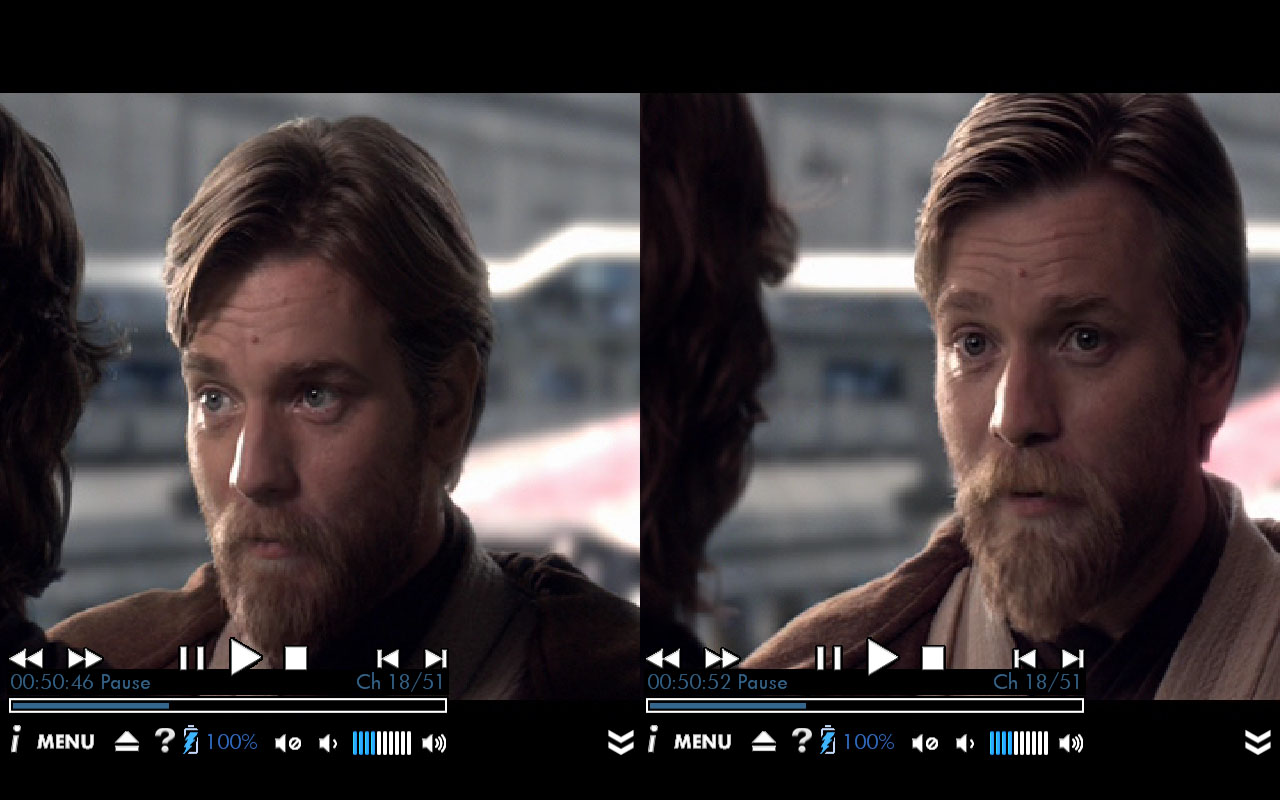

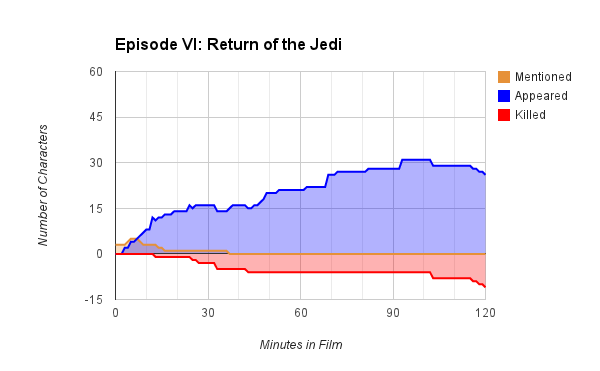
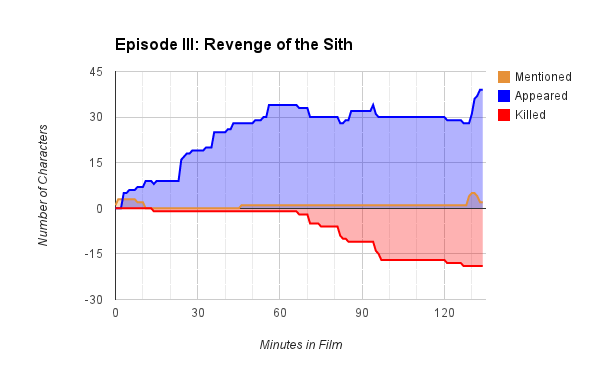
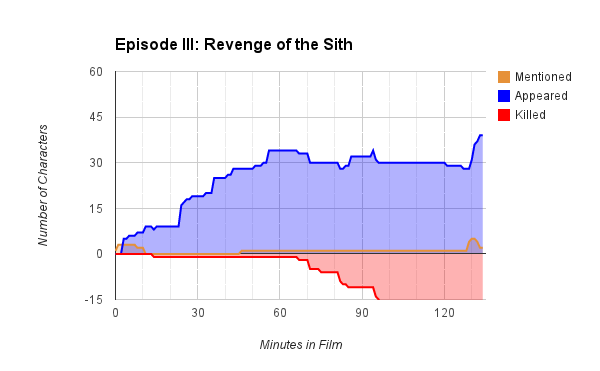
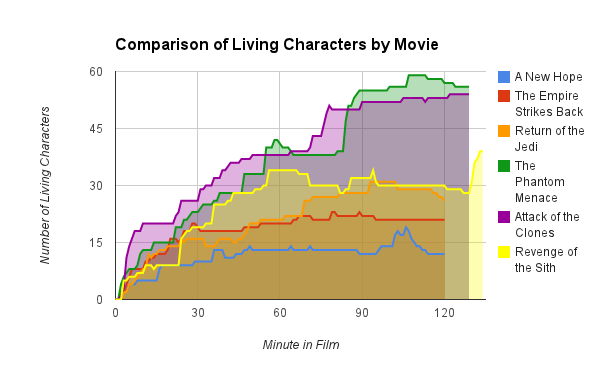
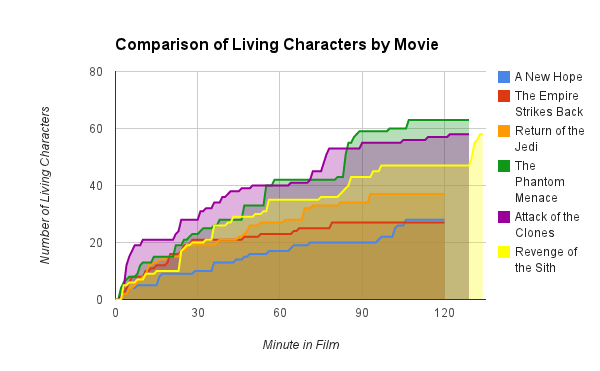.png)
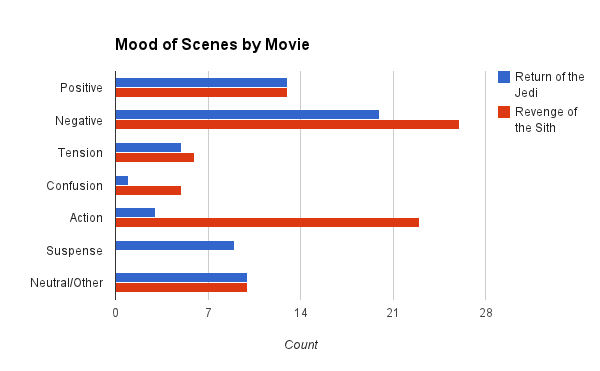

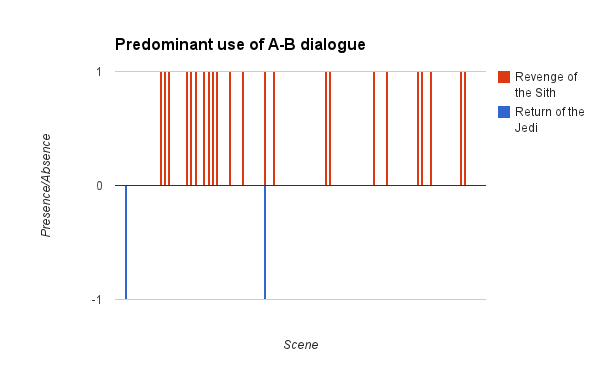






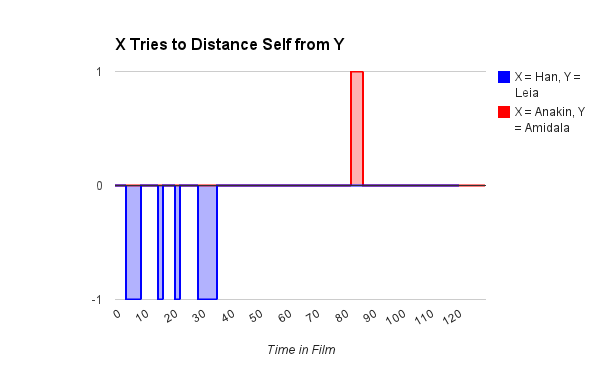.png)
